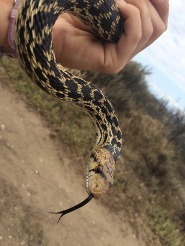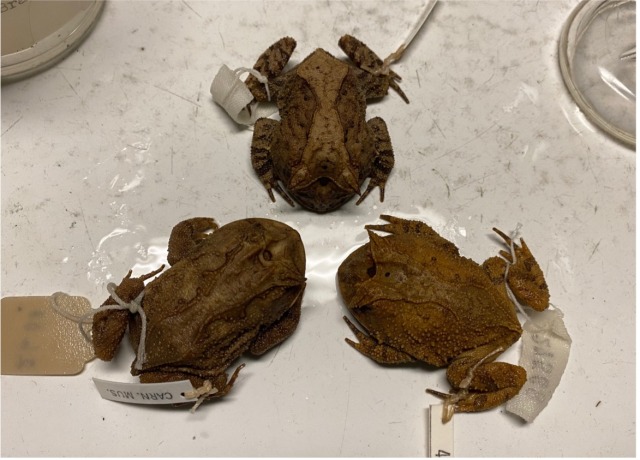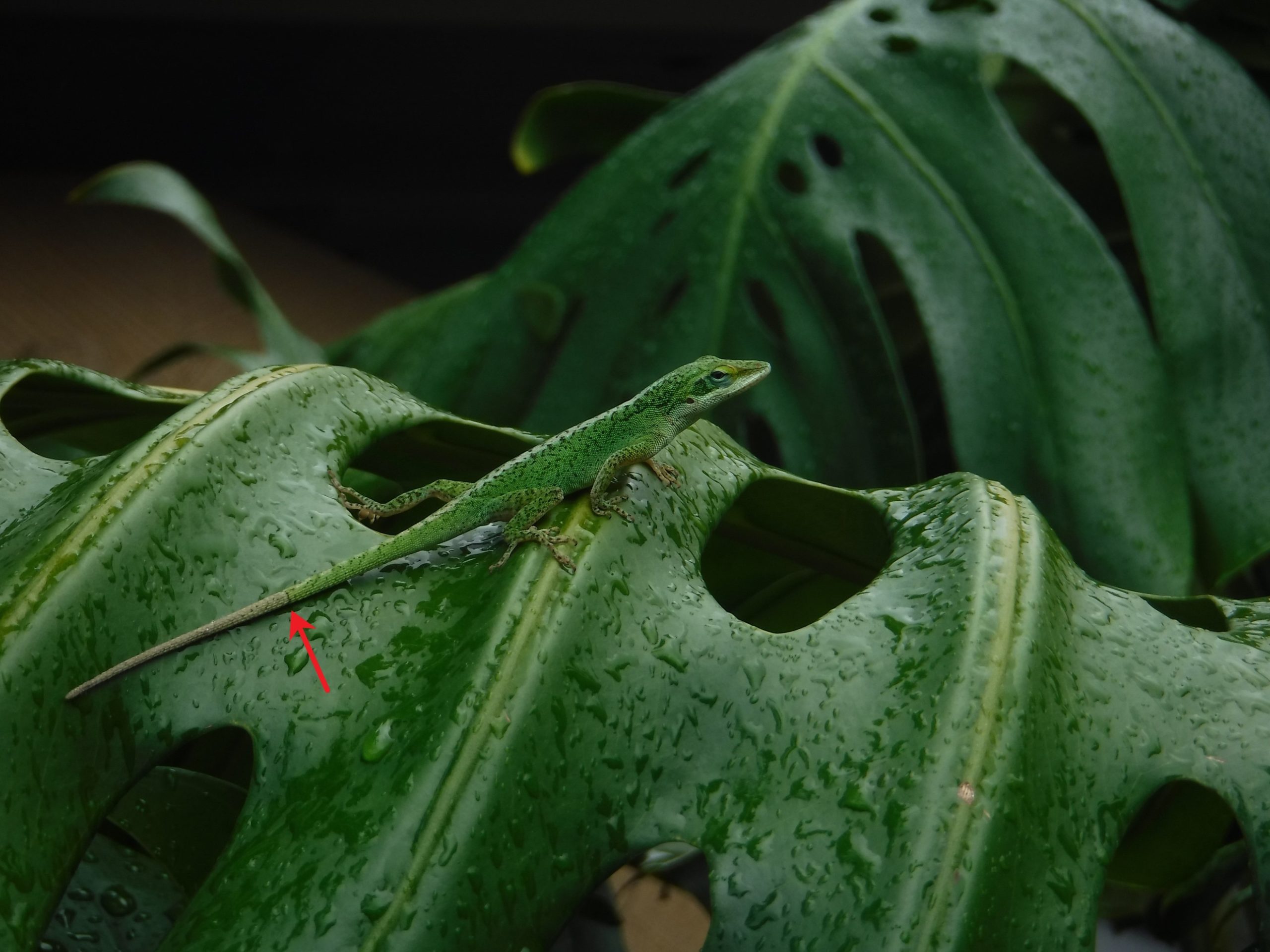An Animal That Fools Its Prey Is Communicating By?
past Stevie Kennedy-Aureate
The beginning of Apr simply means one affair – pranks galore thanks to April Fools Day! Ok, ok, I realize that's non necessarily true equally April too marks that spring has sprung, many small critters are emerging from their hibernations, and we celebrate, amid other things, Earth Day and Arbor Day. But we can all hold that April usually starts with a load of laughs, some fibs, and some fools. In the animal kingdom, however, fooling isn't regulated to i 24-hour interval. In fact, many amphibians and reptiles rely on their ability to fool both predators and casualty to survive.
Masters of Disguise

Ane of the oldest tricks in the book when it comes to fooling another is to transform to look like someone, or something, else. Although herpetofauna lack access to theatrical wardrobes teeming with makeup and outfits, they evolved behaviors and concrete attributes that permit them to imitate other things. The gopher serpent (Pituophis catenifer, Fig. 1), for instance, is a totally harmless colubrid species found across the western and middle United States and into Canada. They are beautiful animals, having splotches of gold, reddish-brown, and black along their bodies, and, due to these colorations, are often mistaken for rattlesnakes. What's more than, when spooked, gopher snakes tend to flatten their heads, coil into a strike position, and apace sway their tails to and fro, a rattlesnake fake that includes a realistic sound component when it occurs in dry grass. Most snakes are lonely animals and prefer to avoid conflict and avoid expending energy in get-away attempts, so scaring abroad potential predators through imitation is preferred over fighting and biting. Frequently times, this imitation works, and potential predators leave the gopher ophidian alone.


Predictably, snakes are not the just masters of disguise. Many frog species have unique morphological features that allow them to resemble other items in nature. The dark brownish coloration and the points to a higher place the eyes of the smoothen horned frog (Proceratophrys boiei) give it the appearance of a leaf (Fig. 2), assuasive it to blend seamlessly into the forest floor and enabling information technology to both evade predators and ambush prey. Similarly, the entirely aquatic Suriname toad (Pipa pipa) looks like a dead foliage in the water due to its brown coloration and flattened body. Unless you're an omnivore that prefers expressionless, low-diet leaves, the imitation tactics of these frogs improves their chances of survival and fools any prey items non clever plenty to see past their disguises.
Deceptive Practices
Not all imitations are meant to help an brute blend in. Sometimes, imitations serve "nefarious" intents. Although non apparent to an outside observer, alligator snapping turtles (Macrochelys temminckii) accept a sneaky tactic to lure prey directly into their mouth. The tongues of these turtles evolved a vestigial slice of flesh, called a lingual lure, to beetle from the tip. Alligator snapping turtles will sit on the bottom of lakes and rivers and open up their powerful jaws to reveal this pink bit of flesh. They then movement the lingual lure around to arrive expect similar a tasty worm, fooling unsuspecting fish correct into their giant maws.
Spider-tailed horned vipers (Pseudocerastes urarachnoides), a species endemic to Iran, utilize a similar tactic, albeit far more than noticeably to the casual observer. Admittedly, the mutual name of this animal gives away the punch line, but, nonetheless, this species of viper evolved to have a unique tail. Much like how a rattlesnakes' rattle is made of modified scales, the spider-tailed horned viper's tail scales evolved then that the last few scales bulge out into a small-scale chimera and the scales leading up to that bulge are heavily keeled, or ridged. While keeled scales are common in most species in the Viperidae family, the keeling on these tail scales is extremely exaggerated, making the scales look like long spikes, or even legs. When you lot combine the long, keeled scales with the big, posterior bulge, the tail of a spider-tailed horned viper actually looks similar a spider! With the snakes speckled coloration assuasive it to blend into surrounding rocks and a solid tail jerk performance, the snake'southward tail looks like a tasty spider dejeuner to unsuspecting birds… which and then become lunch for the snake. False is the best form of flattery… or maybe a reliable manner to fill up your belly!
Now You See Me, Now Yous Don't
Whereas some reptiles and amphibians are the masters of disguise, allowing them to hide from predators or to lure unsuspecting prey, other herps apply subtler actual alterations to fool potential prey, predators, and fifty-fifty conspecifics (animals of the same species). Accept, for instance, color changes. Chameleons often come to mind at any mention of cadger colour changes, but information technology is actually a misconception that chameleons perfectly blend into their surroundings, mimicking every leaf and twig in the background. In truth, chameleons and many other lizard species change colors to improve thermoregulation and to communicate with conspecifics – males signaling to females that they're ready to mate, or relying on darker colors to demonstrate assailment. There are, however, some species of frogs that exercise lighten or darken their hue to alloy into their surroundings. The gray treefrog (Hyla versicolor) is present beyond nearly of the eastern and middle United States and, equally its name implies, is an arboreal species. Because information technology spends its time among green leaves and gray-brownish tree trunks and branches, the grayness treefrog has evolved the ability to modify its body coloration so it can blend in perfectly with the substrate upon which it perches. If it is on a bright dark-green leaf, the frog will shift to a greenish hue. Upon landing on a mossy rock or a lichen-crusted tree trunk, the frog will change to a more gray, blotched hue instead. I second, yous can come across the animal perfectly and, in the side by side, it has completely melted away into its environs.
Leaving Something Backside
Other herpetofauna use more exuberant tactics to evade capture. Dissimilar the camouflage-wielding gray treefrog, many lizard and salamander species will cocky-autotomize their tails to avoid existence eaten. In these instances, the herp has already been seen (or, worse, caught by a herpetologist!) and needs a quick getaway. Running away without a distraction means that the predator will likely give chase and maybe capture the lizard or salamander. However, by self-autotomizing – or breaking off – their tails, these animals increment their chances of escaping. This drastic tactic is effective because the tail continues to wriggle around and motility one time detached from the animals' body, making it a tasty and easy to take hold of meal! Many predators become distracted by the tail, leaving the cadger or salamander free to make its escape. Interestingly, this beliefs is not strictly regulated to predator attacks. I witnessed a prolonged ambitious battle between two male western fence lizards (Sceloporus occidentalis), where ane male lost his tail and, instead of leaving information technology to writhe on the footing and somewhen decompose, the lizard (attempted) to make a jerky, grapple-filled retreat from the other male, all while holding his detached tail in his mouth! Although this seems morbid, information technology's actually quite clever – tails require a lot of free energy and resources to make, simply then the appendage stores energy in the form of meat and fat. This male contend lizard was likely keeping concord of his old tail so that he could subsequently eat information technology and regain those resources. And, don't worry, nearly salamander and lizard species can regrow their autotomized tails (Fig. 3), an ability that many herpetologists have advantage of when we demand tissue for genetic studies.

The listing of herpetofaunal imitators and imposters, pranksters and fibbers goes on and on. Although these disguises and imitations aren't meant to brand other animals giggle and laugh as our April Fool's Day pranks often do, these tactics permit these reptiles and animals to live another mean solar day, evade unwanted attention, or snag a tasty meal. But, at the cease of the day, it actually does beg the question… who is the bigger fool – the fool or the fool that falls for it?
Stevie Kennedy-Gold is the collection manager for the Section of Amphibians and Reptiles at Carnegie Museum of Natural History. Museum employees are encouraged to blog about their unique experiences and knowledge gained from working at the museum.
Related Content
Ask a Scientist: What is an Alcohol House?
Evidence Counts for Absent Creatures – City Nature Claiming
Introducing Matt Brandley, the Herpetology Collection's New Science Communicator and Enquiry Associate
Carnegie Museum of Natural History Weblog Citation Information
Blog author: Kennedy-Aureate, Stevie
Publication engagement: Apr fourteen, 2021
Share this post!
Share this post!
Source: https://carnegiemnh.org/amphibians-and-reptiles-fool-predators-and-prey/
Posted by: brownsproas.blogspot.com

0 Response to "An Animal That Fools Its Prey Is Communicating By?"
Post a Comment